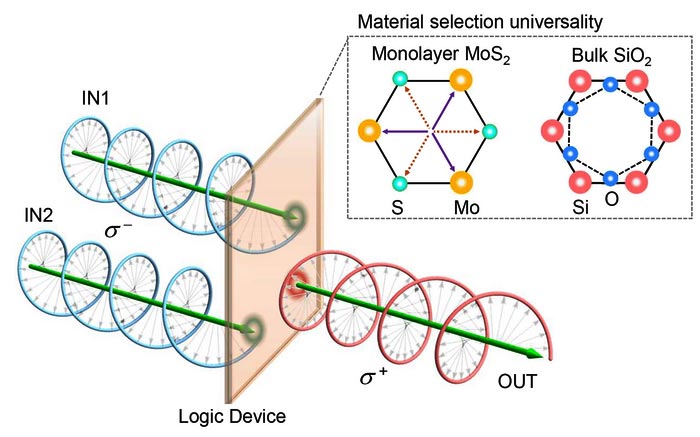New optical computing approach offers ultrafast processing

The optical chirality logic gate is made of a material which emit lights with different circular polarization depending on the chirality of the input beams.
Credit: Yi Zhang / Aalto University
Processing devices based on polarized light run one million times faster than current technology.
Logic gates are the fundamental components of computer processors. Conventional logic gates are electronic – they work by shuffling around electrons – but scientists have been developing light-based optical logic gates to meet the data processing and transfer demands of next-generation computing. New optical chirality logic gates developed by researchers at Aalto University operate about a million times faster than existing technologies, offering ultrafast processing speeds.
The new approach uses circularly polarized light as the input signal. The logic gates are made from crystalline materials that are sensitive to the handedness of a circularly polarized light beam – that is, the light emitted by the crystal depends on the handedness of the input beams. This serves as the basic building block for one type of logic gate (XNOR), and the remaining types of logic gates are built by adding filters or other optical components.
The team also showed that a single device could contain all of their chirality logic gates operating simultaneously in parallel. This is a significant advance over existing logic gates, which can only carry out a single logic operation at a time. Simultaneous parallel logic gates could be used to build complex, multifunctional logic circuits. Finally, the team demonstrated that the chirality logic gate could be controlled and configured electronically, a necessary step for hybrid electrical/optical computing.
Journal: Science Advances
DOI: 10.1126/sciadv.abq8246
Article Title: Chirality Logic Gates
Article Publication Date: 9-Dec-2022
All latest news from the category: Information Technology
Here you can find a summary of innovations in the fields of information and data processing and up-to-date developments on IT equipment and hardware.
This area covers topics such as IT services, IT architectures, IT management and telecommunications.
Newest articles

Pinpointing hydrogen isotopes in titanium hydride nanofilms
Although it is the smallest and lightest atom, hydrogen can have a big impact by infiltrating other materials and affecting their properties, such as superconductivity and metal-insulator-transitions. Now, researchers from…

A new way of entangling light and sound
For a wide variety of emerging quantum technologies, such as secure quantum communications and quantum computing, quantum entanglement is a prerequisite. Scientists at the Max-Planck-Institute for the Science of Light…

Telescope for NASA’s Roman Mission complete, delivered to Goddard
NASA’s Nancy Grace Roman Space Telescope is one giant step closer to unlocking the mysteries of the universe. The mission has now received its final major delivery: the Optical Telescope…



